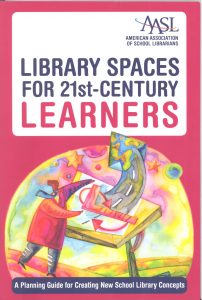Library Spaces for 21st Century Learners
 Library Spaces for 21st-Century Learners: A Planning Guide for Creating New School Library Concepts, by Margaret Sullivan. Published by American Association of School Librarians in 2013, 100 pp.
Library Spaces for 21st-Century Learners: A Planning Guide for Creating New School Library Concepts, by Margaret Sullivan. Published by American Association of School Librarians in 2013, 100 pp.
Margaret Sullivan has dedicated most of her career to educational and public libraries. In fact she has been both President and Executive Director of the American Library Association during her career. Ms. Sullivan is owner of the Library Resource Group LLC, consultants for designing libraries for the 21st century. Whether the library is branded a library, a media center or learning commons as suggested in this book what matters most in her opinion is that the name fits the mission statement for each individual school or library. Ms. Sullivan is committed to the concept that libraries are as relevant to learning and communities as ever. The heading on her business website states “Libraries are more than the heart of every school: they are the nucleus of 21st century learning”.
The author lays the groundwork from starting to plan a library project through library concept layout. Importance is placed on having a mission statement as the focal point for the design. The blueprint must center on what the library or learning commons is being asked to achieve from an educational and social need. Individualized learning with the potential for byod (bring your own devices) must be at least considered if not mandatory for the 21st century learning center. All phases in between the initial planning and final concepts are laid out succinctly. It is strongly suggested that a needs assessment be developed utilizing user sentiment and focus groups. Instructions and other relevant material are presented for conducting surveys.
A concise and comprehensive guide, the author offers detail to help the library planner extract invaluable information for the design of a 21st century resource center. Libraries have evolved through continual change just as our educational processes have been modified. Individualized learning is at the core of today’s educational requirements. Detailed steps are provided for the reader to involve stakeholders and end users to ensure the functionality of the end design fosters the desired result as laid out by the organization in their needs assessment and mission statement.
Will the reader be able to power up their laptop and expediently draft the final CAD design based on the books contents? No, the purpose here is to enable the coordinated team to provide comprehensive specifications to those skilled in computer assisted design to integrate the collaborative ideas into a functional space. Several renderings are included to provide generic ideas for a layout and component inclusion for both elementary and high school libraries.
